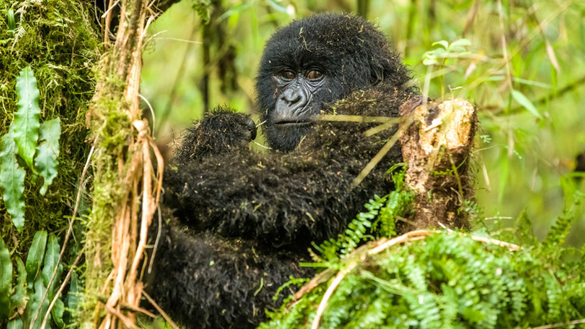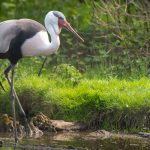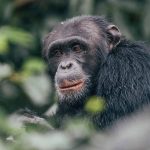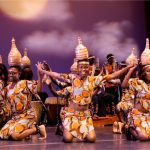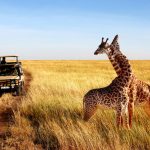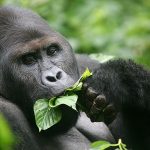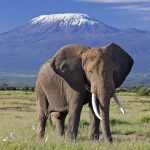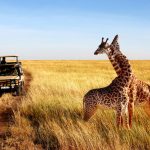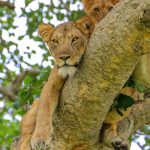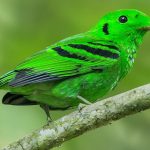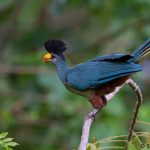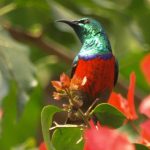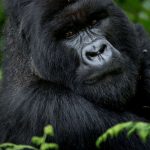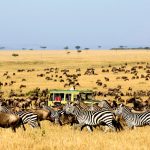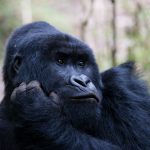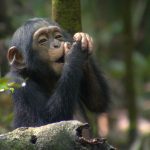Gorilla trekking is one of the most fascinating wildlife experiences. This much sought out activity by primate lovers is only possible in four national parks – Bwindi Impenetrable National Park in Uganda, Virunga National Park in DR Congo, Volcanoes National Park in Rwanda and Mgahinga Gorilla Park in Uganda. Uganda is special because she hosts half of the remaining population of mountain gorillas in two national parks – Bwindi and Mgahinga.
Bwindi Impenetrable Forest National Park is a UNESCO world Heritage site since 1994 because of its great biodiversity. Apart from mountain gorillas, Bwindi currently has 120 species of mammals which include small Antelopes, Giant Forest pigs, the African Golden Cat, the side-striped Jackal and African Civet. You can find several primates in the park including Chimpanzees, L’Hoest’s Monkeys and Black/White Colobus Monkeys. Over 220 species of butterflies and 310 of birds can be spotted in this great forest. Some of the notable bird species include the Frazers Eagle Owl, African Green Broadbill, Brown necked parrots and the White tailed blue flycatcher.
Mgahinga National Park is the other place where visitors can do gorilla trekking in Uganda. It is the smallest National Park in Uganda and sits at the foot of 3 dormant volcanoes. Unlike Bwindi, Mgahinga is an extension or part of the greater Virunga region and conservation area which includes the Virunga National Park in Congo and the Volcanoes National Park in Rwanda. The top attractions are the rare mountain gorillas and golden Monkeys. Visitors can choose to do other activities like spotting smaller primates and mammals, going for forest/nature walks, mountain climbing and birdwatching. How does gorilla trekking in Bwindi compare to Mgahinga? We will discuss it in greater detail in the following chapters.
For a start, we need to note that about 45% of the remaining population of mountain gorillas call Bwindi impenetrable forest home, clearly setting it apart from all the other gorilla parks. It’s a much larger park than Mgahinga and covers an area of 321 Sq Km. Bwindi has more than 35 known gorilla groups, 15 of which are habituated and open for gorilla trekking. Mgahinga has only one habituated gorilla group open for tourism. Moreover, gorilla trekking in Bwindi can be done in four different sectors of the park each hosting more than one gorilla group. Two groups in the Nkuringo and Rushaga sectors are open for the gorilla habituation experience where only 4 visitors are allowed 4 hours with the gorilla family. This unique experience can only be done in Bwindi Impenetrable Forest National Park. It is different from standard gorilla trekking where 8 visitors are allowed to see a gorilla family for only one hour. These initial assessments alone should end the debate for some – but is that all? There may be even more arguments in favor of Bwindi and there must be something special about Mgahinga too as we shall see later.
Spotting the gorillas is now guaranteed in both parks, but there was a time when that wasn’t the case in Mgahinga. The Nyakagezi group which has now settled in Mgahinga was notorious for crossing over to Rwanda and sometimes DR Congo halting all gorilla trekking activities in the park. You just never know when they might decide to resume their cross-border visits.
Gorilla trekking in both Bwindi and Mgahinga can to be strenuous involving hiking through rough and steep terrain to locate the gorilla families. However, it is generally accepted that the Nyakagezi group in Mgahinga are a much easier group to track. They live in a smaller range compared to most of the gorilla groups in Bwindi. As a large forest, visitors to Bwindi might have to go deeper in the forest in search of some of the gorilla groups. However some of the gorilla groups in Bwindi live very near the starting points and finding them takes less than two hours. Did I forget to mention that gorilla trekking in Mgahinga has fewer crowds? Yes. There are fewer visitors with less crowds during the briefing and after gorilla trekking and this to some may allow more privacy to peacefully enjoy the great scenery around the park.

One clear advantage Mgahinga has over Bwindi is that it is the only park in Uganda where visitors can spot both the endangered golden monkeys and Mountain Gorillas. This implies that visitors can combine gorilla trekking with golden monkey tracking. However having the cute Golden Monkeys is not a complete knockout for Mgahinga because Bwindi has got Chimpanzees. While doing gorilla trekking, visitors to Bwindi can spot Chimpanzees along the trails. Mgahinga has no chimpanzees.
As already noted earlier, Gorilla Trekking in Mgahinga gives visitors opportunities to take part in mountain hiking unlike in Bwindi. There are three Volcanoes in Mgahinga to choose from – Mount Muhavura, Mount Sabinyo and Mount Gahinga. Climbing to the top of any of these volcanoes will reward visitors with stunning views of Mgahinga National Park and opportunities to spot birds, forest mammals and primates like Golden Monkeys along the trails. There is no mountain climbing in Bwindi – A clear win here for Mgahinga.
Those who love exploring caves might want to consider gorilla trekking in Mgahinga. Visiting the Garamba and Muhavura caves that were once used by the Batwa for food storage, royal housing, gathering and preparing for war makes gorilla trekking in Mgahinga worthwhile. Both parks allow visitors to go visit the Batwa people during their time in the park. The Batwa pygmies were the dominant and original community living in the park for thousands of years before they were sadly evicted from the park in 1991. The continued reduction in number of mountain gorillas, golden monkeys and other park creatures where partly attributed the presence of the Batwa in the park. To take gorilla conservation programmes to the next level, it was agreed that it was necessary for the Batwa to be relocated elsewhere. This decision was no win-win for everyone because the Batwa have never fully integrated in their new homes or with their neighboring communities. Experiencing the Batwa way of life is generally more exciting and fulfilling in Mgahinga National Park. The Batwa trail in Mgahinga allows visitors to experience the Batwa way of life for more than 5 hours and within the park unlike in Bwindi. Some of the Batwa in Mgahinga are allowed in the forest to act as local guides while introducing you to their culture, ancient caves, former war hideouts, sacred places, gods, dances, language, traditional stories, way of dressing and way of hunting. In Bwindi, visitors usually go to see the Batwa outside the park for a shorter time after gorilla trekking.
Both National parks provide tourist with opportunities for nature walks but Bwindi might just have the edge here once again. Visitors to Bwindi forest can take walks through several established trails like the waterfall trail, Muzubijiro loop trail, Bamboo trail and the Rushura trail. One can also visit the local communities around Buhoma and learn about local beer brewing, language, and dances.
The cost of a Gorilla trekking safari is similar for both national parks. Gorilla permits in both Bwindi Impenetrable National Park and Mgahinga National Park go for $600. However the entire gorilla tour might cost between $1600 and $1900 depending on the quality of accommodation and transport.
Bwindi Impenetrable National Park is strategically located near one of Uganda’s largest and most popular game parks – Queen Elizabeth National Park. It takes only two hours of driving after gorilla trekking for visitors to visit Queen Elizabeth National Park to spot elephants, crocodiles, Hippopotamus, the Uganda Kob, Antelopes, Buffaloes and the rare tree climbing lions in the Ishasha sector of the park. Moreover if one missed the chimps during gorilla trekking, they can go for chimpanzee trekking at the unique Kyambura gorge or visit the salt mining lake near the park to spot the beautiful Flamingo birds. This proximity to Queen Elizabeth National Park allows visitors to easily combine gorilla trekking and game drives making for a true amazing African wildlife safari.
The same gorilla trekking rules and regulations apply to both Bwindi and Mgahinga. These rules were designed to help protect the gorillas from human diseases and irritation as a result of prolonged human presence. Only eight visitors are allowed to track a gorilla group in a day and for strictly one hour at most. You must be at least 15 years to do gorilla trekking in both parks. Showing up sick with transferable diseases is prohibited. You can’t smoke, use flashlight or make unnecessary noise while in the presence of gorillas in both Bwindi and Mgahinga.
The packing lists during gorilla trekking in Bwindi and Mgahinga are the same. Whichever park you choose, you would need to come with long sleeved shirts, pants, water-proof hiking shoes, long stockings, a hut, sunscreen and a walking stick. Items like prescription drugs, a camera, binoculars, water and snack will ensure you have a comfortable time during gorilla trekking in both gorilla parks.
Regarding transport, you can access both Mgahinga and Bwindi National parks from the capital Kampala or Kigali in Rwanda by road or air. However the distance to Bwindi is shorter in comparison to Mgahinga. If you are using road transport, you can use a private car or public transport. From Kampala, there are several routes that you can use. The journey from Kampala to Kisoro the largest town near the two parks is about 7 hours. If you think the journey from Kampala to Kisoro is too long, then you access both Bwindi and Mgahinga using the shorter distance from Kigali (4 hours) in Rwanda or by air from Kampala in Uganda. Aerolink and Fly Uganda operate flights from Kajjansi in Kampala and Entebbe to Kisoro Airstrip near Bwindi. Those doing gorilla trekking in Bwindi can actually land directly in Kihihi Airstrip which is not far from Ruhija or Buhoma sectors in Bwindi. Still wondering which national park is best for gorilla trekking in Uganda? Let me summarize it for you to make things clear.
Bwindi is a world heritage site hosting half of the worlds remaining population of mountain gorillas. It is a park with 15 habituated gorilla families where visitors can track gorillas or go for the gorilla habituation experience while sighting chimpanzees along the way. Nature walks are excellent and well organized in Bwindi with excellent trails. Reaching Bwindi from Kampala or Kigali by road takes a shorter distance than to Mgahinga. Bwindi’s location near Queen Elizabeth national parks allows primate lovers go for a full African Safari. Mgahinga has one gorilla family that is perhaps the largest habituated group found in all known mountain gorilla parks. There are less crowds during gorilla trekking in Mgahinga while offering visitors are chance to go for golden monkey trekking, mountain hiking and a more complete experience with the Batwa pygmies. That’s it. The final choice is yours.


